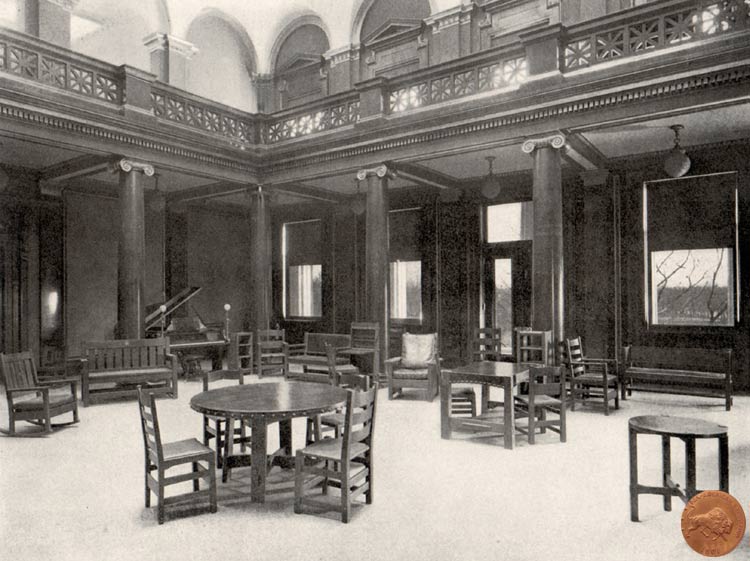
The Grand Staircase in the State Court, showing the piano and one of the twig chairs.

View of the other side of the same room.

The Gallery (looking toward the open court) from the side gallery.
The interior of the building was furnished with loaned furniture, rugs, hangings in the corridors, dining room, governor's room, and the room used by the Daughters of the American Revolution from D.E. Morgan, Son and the Allen Company. The colonial rug on the floor of the room of the DAR was manufactured by the Morgan Carpet Cleaning and Rug Weaving Works. Lorillard Refrigerator loaned a number of large refrigerators. The reception room's Mission furniture was on loan from the Joseph P. McHugh Company, New York. 118,554 visitors signed in at the building from July to November, 1901. State organizations met in the building in the audience room. In addition to space set aside for the DAR, the State Bar Assocation also had a room on the second floor. Its furnishings were "somewhat simple," and the walls were decorated by portraits of prominent legal fraternities of the county. The basement provided a room for parking bicycles and a dining room for visitors to eat lunches they brought with them, a common practice among state buildings which served as a central contact point for friends or relatives visiting the Exposition. The piano in the grand hall (aka State Hall) was specially constructed for the building by Steinway. It was mahogany, "elegantly polished and decorated in gold. Upon the cover is the State coat of arms reproduced in gold." Its cost was $2500. Paintings and artwork filled the walls. One exhibit of 50 pictures came from the New York State Regents in Albany. They were from the Home Educator series, described as generally instructive on subjects pertaining to "history, the educational development of the Empire State." A painting of Christopher Columbus by Sir Antonio Moro, painted in 1543 for the Court of Spain, was loaned by its owner, Charles F. Gunther of Chicago; it had been the first exhibit received by the Chicago World's Fair in 1893. Another set of 80 paintings was sent from the Hope Art Gallery in Watkins Glen, installation for these was overseen by J.D. Hope. In the left corner of the first image below is the Ogden Rustic Chair, made by Moses Ogden of Angelica. "Mr. Ogden is a veteran of the Civil War and built the chair as a memorial of the latter end of a busy life. The chair is 8 feet high and 4 feet across and weighs about 700 pounds. It is built of 1200 pieces of wood, every one of which is a natural crook. They include 50 different kinds of wood grown in New York State. The construction is very symmetrical. When Mr. Ogden glued on a piece of wood in the back or arm on one side, he pottered about in the woods until he came across its exact duplicate as to size, grain and color. Then he took this home and added it to the opposite side. In this pursuit he roamed over a large part of Alleghany county. "Mr. Ogden contributed two other rustic chairs to the New York State building, one of which is made entirely of sumac. These pieces of furniture are admired by thousands who visit the building daily." Images below with a copper icon in the lower right hand corner have a present-day counterpoint which you may view by clicking. |

The Grand Staircase in the State Court, showing the piano and one of the twig chairs.

View of the other side of the same room.

The Gallery (looking toward the open court) from the side gallery.